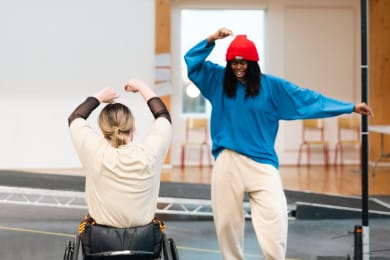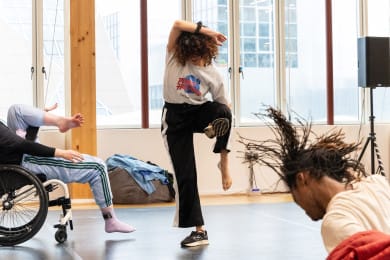Postcards from the Studio – Week 7

This week our Production Manager, Froud, built a platform and ramp for us to explore levels within the piece. The platform allows the company to be ‘on the same level’ as one another and to have level eye contact with one another. It’s unlocked creative possibilities and fulfilled a longing one of the company members expressed as “it would be great if the world could come to me”. I feel like this desire beautifully articulates our ability to flip power: rather than ‘including’ disabled folk in normative structures we can build structures that mean we are met. It’s part of their attempt to build a utopia for this group of performers, however fleeting.
Sound System Culture
Last week Yassmin Foster gave us a workshop into the history of sound system culture. Yassmin is a dance artist who also runs Legs 11 sound system – a sound system she, and her sister, inherited from their father.
It was fascinating to learn about how sound system culture came to the UK from Jamaica in the early 60’s. Yassmin took us through the sound and the moves of Ska music, Ska being the sound birthed as Jamaica gained independence in 1962. Yassmin then took us through the evolution of Ska, with influences from the UK and the US into Jungle, and then Garage and then House. She talked about the celebration and optimism of Ska music, the irresistible bounce and suspension in it, the space dancers could take up with their movements in the outside living of the Jamaican tropics. How we see the sound and the movement change with the next generation: the sound is harder and sharper, the movements tighter, more constrained in the indoor spaces of the UK. There is a sense for the second generation that ‘this is hard’. In the tighter spaces where Garage played, the movements are quicker, smaller, sharper. The dancers create space, demand possibility by pointing to the sky or to the ground. Even under these conditions, they are still attempting to carve out a space, a dance, a beat for themselves.
The thing that’s stayed with me from Yassmin’s workshop, is how a sound and dance is born of the needs of the people of a particular time: the need to celebrate or share frustrations, the need to be in a space that welcomes you, the need to belong. That resonates so deeply with me, when I think about this project and the desire the create the sound, the dance, the space that expresses the needs of the company as folk in 2025. I come back to something Dan has said during the process “if we ask for what we need, can we get free?”
I’d like to share a few brilliant quotes from Yassmin, as provocations that might spark something for you:
- “How does a sound move you to your core? Do you recognise when a sound does what you need it to do?”
- “The beat carries you… it will be there if you miss it.”
- “At the end of the dance there is knowing. We go back to the dance floor to know more” (Yassmin paraphrasing Audrey Lourde’s writing on Knowing).
And I’d like to leave you with a quote from one the company dancers on dance as resistance – as a freedom practice:
“It’s a resistive act to dance, especially if you look different. Dance is a way of knowing yourself. The more you dance, the more you fight.” – Annie Edwards
More next week,
Raquel
With the support of Dance Reflections by Van Cleef & Arpels.
This commission was also supported by Arts Council England, and Cockayne Grants for the Arts, held at The London Community Foundation.
Please head to our Over and Over (and over again) page for more information about this work, the confirm dates and for the full list of credits.













